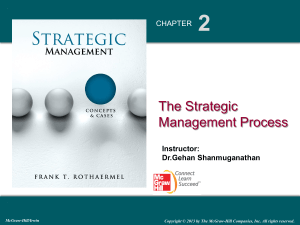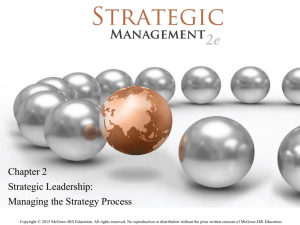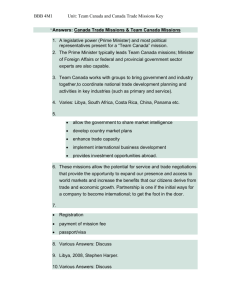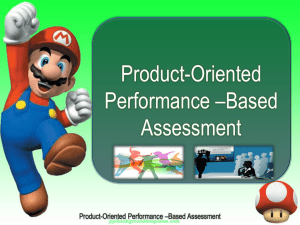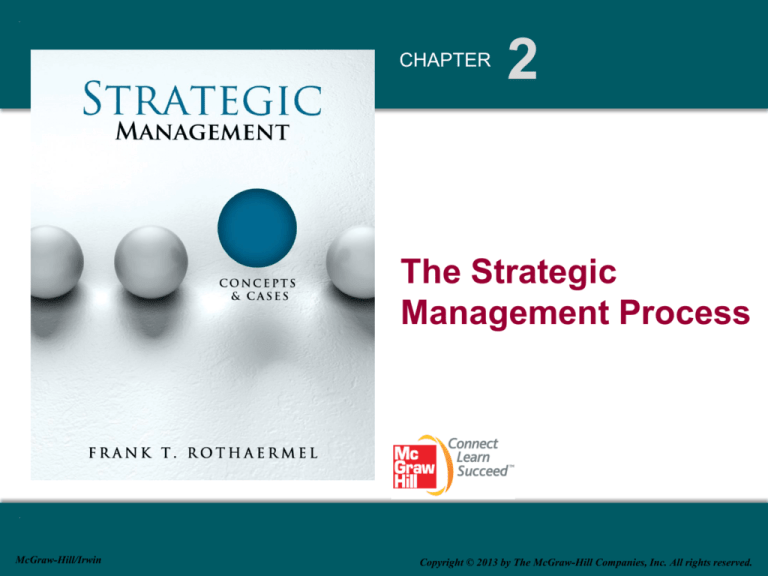
CHAPTER
2
The Strategic
Management Process
McGraw-Hill/Irwin
Copyright © 2013 by The McGraw-Hill Companies, Inc. All rights reserved.
Part 1 Strategy Analysis
.
LO 2-1 Explain the role of vision, mission, and values in the strategic
management process.
LO 2-2 Describe and evaluate the role of strategic intent in achieving
long-term goals.
LO 2-3 Distinguish between customer-oriented and product-oriented
missions and identify strategic implications.
LO 2-4 Critically evaluate the relationship between mission statements and
competitive advantage.
LO 2-5 Explain why anchoring a firm in ethical values is essential for longterm success.
LO 2-6 Compare and contrast strategic planning, scenario planning, and
strategy as planned emergence, and discuss strategic implications.
2-3
Chapter Case 2
Teach For America: Inspiring Future Leaders
• TFA Mission: Eliminate educational inequality
Started by an undergraduate student,
Wendy Kopp
Inspiring mission
Provide a meaningful service option for bright young people
• Make teaching to the neediest high prestige
Over 45,000 applicants for 4,500 jobs
TFA Video
Teach For America – Inspiring Others
• What are the key issues in the opening case?
• How was TFA able to successfully recruit?
Established an inspiring mission
Appealing to the target demographic
Clear communication of the goals of the organization
The program is highly selective
• Would TFA have succeeded as a for-profit firm?
Vision, Mission, and Values
• What are visionary organizations?
Begin with the end in mind
Similar to designing & building a home
Vision – what to ultimately accomplish?
Mission – what is the firm about?
Values – how to accomplish goals?
Frank Lloyd Wright
EXHIBIT 2.1
Teach For America:
Vision, Mission, and Values
• Vision
• One day, all children in this nation
will have the opportunity to attain
an excellent education.
• Mission
• Eliminate educational inequality
by enlisting our nation’s most
promising future leaders in the
effort.
• Values
• Relentless pursuit of results.
• Sense of possibility.
• Disciplined thought.
• Respect and humility.
• Integrity.
Vision, Mission, and Values
• What is forming strategic intent?
Staking out a desired leadership position in the long
term that far exceeds a company's current situation
Often used in Japanese corporate settings
Canon will "beat Xerox"
Effective use of stretch goals
Competitive advantage for tomorrow
STRATEGY HIGHLIGHT 2.1
Winning Through Strategic
Intent: The “Pocketable” Radio
• Small Japanese Company after WWII,
founded by Masura Ibuka
Invented an electric rice cooker
Wanted to license the transistor from Bell Labs in U.S.
Japanese Government & Bell Labs both said NO
Persisted with request – Finally,1953 got transistor.
“Beat Bell Labs” to pocket-sized radio
1957 – Launched world’s FIRST pocket radio
1958 – Changed company name to….
1–9
LO 2-1 Explain the role of vision, mission, and values in the strategic
management process.
LO 2-2 Describe and evaluate the role of strategic intent in achieving longterm goals.
LO 2-3 Distinguish between customer-oriented and product-oriented
missions and identify strategic implications.
LO 2-4 Critically evaluate the relationship between mission
statements and competitive advantage.
LO 2-5 Explain why anchoring a firm in ethical values is essential for longterm success.
LO 2-6 Compare and contrast strategic planning, scenario planning, and
strategy as planned emergence, and discuss strategic implications.
Vision, Mission, and Values
• Customer-Oriented Missions
• Define the firm in terms of solutions for customers
Disney: "Make People Happy"
Enhanced strategic flexibility
NOT the same as listening to customers
• Product-Oriented Missions
• Define the firm in terms of products or services
U.S. Railroads: "Safest… North American railroad”
Missed the opportunity to move into delivery before
UPS & Federal Express
Defining the Business:
The Starting Point of Strategy
• Example: Fall of the Railroads
“They let others take customers away from them because
they assumed themselves to be in the railroad business
rather than in the transportation business. The reason
they defined their industry wrong was because they were
railroad oriented instead of transport oriented; they were
product oriented instead of customer oriented.”
Theodore Levitt “Market Myopia”
Mission Statements and
Competitive Advantage
• Do mission statements help gain and sustain
competitive advantage?
Results are inconclusive
Need strategic commitments to succeed
(e.g., Boeing Dreamliner)
• Positive associations – Visionary firms, like Merck
• Negative associations – Better World Books
• No associations – Intel
LO 2-1 Explain the role of vision, mission, and values in the strategic
management process.
LO 2-2 Describe and evaluate the role of strategic intent in achieving longterm goals.
LO 2-3 Distinguish between customer-oriented and product-oriented
missions and identify strategic implications.
LO 2-4 Critically evaluate the relationship between mission statements and
competitive advantage.
LO 2-5 Explain why anchoring a firm in ethical values is essential for
long-term success.
LO 2-6 Compare and contrast strategic planning, scenario planning, and
strategy as planned emergence, and discuss strategic implications.
Living the Values
• Ethical standards and norms that govern behavior.
• McKesson (health care) – ICARE
Shared principles a framework for daily interactions
• Dark side of values
Bernard Madoff
Ponzi scheme estimated at $65 billion in fraud
Enron
One of the largest bankruptcies in U.S. history
Over 50,000 jobs lost (Enron and Arthur Andersen)
LO 2-1 Explain the role of vision, mission, and values in the strategic
management process.
LO 2-2 Describe and evaluate the role of strategic intent in achieving longterm goals.
LO 2-3 Distinguish between customer-oriented and product-oriented
missions and identify strategic implications.
LO 2-4 Critically evaluate the relationship between mission statements and
competitive advantage.
LO 2-5 Explain why anchoring a firm in ethical values is essential for long
term success.
LO 2-6 Compare and contrast strategic planning, scenario planning,
and strategy as planned emergence, and discuss strategic
implications.
The
The Evolution
Evolution of
of Strategic
Strategic Management
Management
DOMINANT
THEME
MAIN
ISSUES
CONCEPTS
&
TECHNIQUES
IMPLEMENTATION
1950s
1960s
Early-mid Late1970s
1970s
early 1980s
Late 1980s Late 1990s
early 1990s early 2000s
Budgetary
planning &
control
Corporate
planning
Corporate
strategy
Quest for
competitive
advantage
Financial control
Planning growth
Diversifica- Positioning
ion
Competitive
advantage
Budgeting
project appraisal
Forecasting &
investment
planning
Portfolio
planning.
Synergy
market
share
Resource
analysis.
Case
competences
Emphasis on
financial
management
Rise of
corporate planning
departments
& formal
planning
DiversifiIndustry/market
cation.
selectivity.
Quest for
Active asset
global
management
market share
Analysis of
industry &
competition
Analysis of
industry &
competition
Strategic
innovation
The “New
Economy”
Innovation &
knowledge
Dynamic
sources of
advantage
Knowledge
management
cooperation
Restructuring Virtual orgaBPR.
nization.
Refocusing
Alliances
Outsourcing
Quest for
critical mass
17
Strategy as Strategic Planning
• Top-down rational planning
Define mission, vision, and goal (strategic intent)
External analysis of opportunities and threats
Internal analysis of strengths and weaknesses
Create strategic fit through SWOT
Formulate appropriate strategy
Implement chosen strategy
Monitor performance and modify if necessary
assess
environmental
factors
Identify
current
mission
and
strategic
goals
Strategy formulation Strategy implementation
Conduct
competitive
analysis:
•strengths
•weakness
•opportunity
•threats
Develop
specific
strategies:
•corporate
•business
•functional
carry out
strategic
plans
maintain
strategic
control
assess
organisational
factors
619
Fundamental Question of the Choice of Goals:
Planning for what Purpose(s)?
• Profitability (net profits)
• Efficiency (low costs)
• Market Share
• Growth (e.g., increase in total
assets, sales, etc)
• Shareholder Wealth (dividends
plus stock price appreciation)
• Utilization of Resources
(e.g., ROE, ROI)
• Reputation
• Contribution to Stakeholders
(e.g., employees, society)
• Survival (avoid bankruptcy)
20
Strategy as Scenario Planning
• Scenario planning
Envision different "what-if" plans
Generates a dominant plan
Must implement the most probable option
Keeps other scenarios in the event of changes…
"Arab Spring" impact on the oil industry?
Good example of the AFI framework
Scenario planning at Shell
EXHIBIT 2.2
Scenario Planning in the AFI Strategy Framework
STRATEGY HIGHLIGHT 2.2
Shell’s Future Scenarios
• Petroleum industry use of scenario planning
Shell made right move in the 1960s
Again in the 1980s
Communism might fall in Soviet Union
Now projecting 20% energy from renewables by 2025
1–23
Strategy as Planned Emergence
• Strategic Initiative
Google 50% of the firm's new products come from the
"20% rule" (one day a week on own ideas)
Enron Wind investment by GE
• Mintzberg Planned Emergence
• Strategy can come from top or bottom:
Some intended strategies drop off in the process
Allows for new emerging ideas to become realized
Resource allocation process
Serendipity can have dramatic effects
Strategic Initiatives and Serendipity
• Japan Railways
Constructing a bullet train through the
mountains north of Tokyo, which
required many tunnels
Persistent flooding
Complex engineering plans to drain the water
Maintenance worker suggested that the fresh water off the
mountains should not be drained, but rather should be bottled
1,000 vending machines on 1,000 railroad platforms in and around
Tokyo, and home delivery of water, juices, and coffee followed.
The employee’s proposal had turned this “bottom-up” strategy into
a multi-million dollar business.
EXHIBIT 2.3
Mintzberg’s Planning Framework
Strategy
Strategy Making
Making :: Design
Design or
or Process?
Process?
Strategy as Design
Strategy as Process
Planning and
rational choice
Many decision makers
responding to multitude of
external and internal forces
INTENDED
STRATEGY
EMERGENT
STRATEGY
REALIZED STRATEGY
Mintzberg’s
Mintzberg’sCritique
Critiqueof
ofFormal
FormalStrategic
StrategicPlanning:
Planning:
•The
fallacy
of
prediction
–
the
future
•The fallacy of prediction – the futureisisunknown
unknown
•The
fallacy
of
detachment
-impossible
•The fallacy of detachment -- impossibleto
todivorce
divorceformulation
formulationfrom
from
implementation
implementation
•The
•Thefallacy
fallacyof
offormalization
formalization--inhibits
--inhibitsflexibility,
flexibility,spontaneity,
spontaneity,
intuition
intuitionand
andlearning.
learning.
27
STRATEGY HIGHLIGHT 2.3
“It’s Not What We Do!”
• Starbucks
Autonomous action of mid-level manager
Tenacity and persistence of a store manager in
Southern California
Risk of failure
Possible career-limiting action
Organization must be willing to accept new ideas
Frappuccino was born!
Contributing 20% of the $11billion in revenues for Starbucks
in 2010.
1–28
An
An optimal
optimal decision
decision
isis possible
possible
All
All relevant
relevant information
information
isis available
available
All
All relevant
relevant information
information isis
understandable
understandable
All
All alternatives
alternatives are
are known
known
Managers
Managers as
as
decision
decision makers
makers
Assumptions
Assumptions of
of the
the
Rational
Rational Model
Model
Rational
Rational
decision
decision
making
making
All
All possible
possible outcomes
outcomes known
known
9
BARTOL, MANAGEMENT: A PACIFIC RIM FOCUS 3E
© McGraw-Hill Australia 2001
29
Time
Time constraints
constraints
Limited
Limited ability
ability to
to
understand
understand all
all factors
factors
Inadequate
Inadequate base
base
of
of information
information
Limited
Limited memory
memory of
of
decision-makers
decision-makers
Managers
Managers as
as
decision
decision makers
makers
Satisficing
Satisficing
‘Satisficing’
‘Satisficing’
decision
decision
making
making
Poor
Poor perception
perception of
of factors
factors
to
to be
be considered
considered
in
in decision
decision process
process
10
BARTOL, MANAGEMENT: A PACIFIC RIM FOCUS 3E
© McGraw-Hill Australia 2001
30
31
32
33
Take-Away Concepts
LO 2-1
Explain the role of vision, mission, and values in the strategic
management process.
A vision captures an organization’s aspirations. An effective vision inspires
members of the organization.
A mission statement describes what an organization actually does and why it
does it.
Values define the ethical standards and norms that should govern the behavior
of individuals within the firm.
Success is created twice: first analyzing a mental model and second formulating
and implementing a strategy to make a vision a reality.
LO 2-2
Describe and evaluate the role of strategic intent in achieving longterm goals.
Strategic intent finds its expression in stretch goals that exceed the firms’ existing
resources and capabilities by a large margin.
Effective use of strategic intent creates at all levels of the organization an
obsession with winning that can help companies ascend to global leadership.
Take-Away Concepts
LO 2-3 Distinguish between customer-oriented and product-oriented
missions and identify strategic implications.
Customer-oriented missions define businesses providing solutions to
customer needs.
Product-oriented missions define a business in terms of a good or
service provided.
Customer-oriented missions provide managers with more strategic
flexibility than product-oriented missions.
LO 2-4
Critically evaluate the relationship between mission
statements and competitive advantage.
Mission statements can help a firm achieve superior performance,
but mission statements by themselves do not directly affect firm
performance.
To be effective, mission statements need to be backed up by hard-toreverse/irreversible commitments.
Take-Away Concepts
LO 2-5
Explain why anchoring a firm in ethical values is essential for
long-term success.
Ethical core values enable employees to make day-to-day decisions that are
guided by correct principles.
Values are guardrails to keep a company on track for competitive advantage.
LO 2-6 Compare and contrast strategic planning, scenario planning,
and strategy as planned emergence, and discuss strategic
implications.
Top-down strategic (long-range) planning works reasonably well when the
environment does not change much.
In scenario planning, managers envision different what-if scenarios and prepare
contingency plans that can be called upon when necessary.
Strategic initiatives can be the result of top-down planning by executives or can
emerge through a bottom-up process from deep within the organization.
A firm’s realized strategy is generally a combination of its top-down intended
strategy and bottom-up emergent strategy, resulting in planned emergence.

